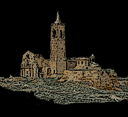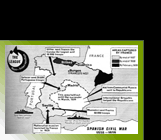| 17th - 18th July 1936 |
Throughout Morocco and Spain military garrisons
(aided, in places, by the Guardia Civil and the Falange) rose
in revolt against the Republican Government. |
| 19th July 1936 |
The Insurgents (or Nationalists) succeeded in seizing power
in Morocco, Navarre, Galicia, Old Castile and Seville, but
were thwarted in the key cities of Barcelona and Madrid.
Santiago Casares Quiroga (of the Left Republican Party) resigned
from the post of Prime Minister of the Republic. President
Manuel Azana asked Diego Martinez Barrio (a member of the
Republican Union Party) to form a moderate government that
could negotiate with the rebels. When Barrio was unable to
form a government that enjoyed any real support he resigned.
Professor Jose Giral (of the Republican Party) replaced him
and ordered that arms be distributed to the workers.
General Francisco Franco flew from Tenerife to Tetuan to
take over command of the Army of Africa. |
| 20th July 1936 |
Prime Minister Giral appealed to the French Socialist Government
(whose Prime Minister was Leon Blum) for arms supplies.
General Francisco Franco sent emissaries to Hitler and Mussolini
to ask for military aid and technical assistance.
The nominal leader of the Rising, General Jose Sanjurjo,
was killed when the aircraft bringing him from Portugal to
Burgos crashed on take-off. |
| 20th July - 27th September 1936 |
THE SIEGE OF THE ALCAZAR
When it became apparent that the Rising in Madrid had failed,
the Nationalist supporters in Toledo, which is 40 miles to
the Southwest of the capital, occupied the Military Academy
in the Alcazar fortress. The garrison was mainly drawn from
the local Guardia Civil and Falange, and was commanded by
the Commandant of the Academy, Colonel Jose Moscardo. For
two months the defenders held out against the Republican Militia
units besieging them; they were finally relieved when troops
from the Army of Africa, led by Colonel Jose Varela, stormed
Toledo. The raising of the siege of the Alcazar did much to
enhance General Franco's reputation, but the diversion of
Varela's troops from the advance on Madrid gave the capital's
defenders further time to prepare their defences.
|
| 21st July 1936 |
El Ferrol, the main naval base in the Northwest of Spain,
surrendered to the Nationalists. As a result the Nationalists
acquired a battleship, Espana, two cruisers, Republica and
Almirante Cervera (with another two, Baleares and Canarias,
under construction), and a destroyer, Velasco. |
| 22nd July 1936 |
The Nationalists captured Alto de Leon to the Northwest of
Madrid. |
| 23rd July 1936 |
The Committee of National Defence (the Nationalist Government)
met for the first time in Burgos. |
| 25th July 1936 |
The Nationalists captured the Somosierra Pass to the North
of Madrid. |
| |
The first shipment of French aircraft sent as aid to the Republican
Government arrived in Spain. |
| 26th July 1936 |
The COMINTERN agreed to send volunteers and funds to aid
the Republic.
Adolf Hitler agreed to send military aid to the Nationalists
after negotiating with representatives sent to Berlin by General
Franco. |
| 27th - 30th July 1936 |
The airlift, which was to carry the Army of Africa from Morocco
to the Mainland, began when German and Italian transport aircraft
arrived in Spain's North African territories |
| 3rd August 1936 |
The Nationalists began an offensive in Extremadura |
| 8th August 1936 |
The French Government changed its attitude towards Republican
Spain and stopped further sales of arms and ammunition. This
marked the beginning of the Non-Intervention Policy. |
| 11th August 1936 |
The Nationalist gunboat Eduardo Dato was sunk at Algerciras
by the Republican battleship Jaime I. |
| 13th August 1936 |
The Republican battleship Jaime I was damaged by a Nationalist
air attack off the coast at Malaga. |
| 14th August 1936 |
Nationalist forces, drawn from the Army of Africa and led
by Colonel Juan Yague, captured Badajoz. The two parts of Nationalist
Spain were now linked. |
| 16th August - 3rd September 1936 |
REPUBLICAN INVASION OF MAJORCA
On 9th August a Republican expeditionary force of Catalan
and Valencian troops, commanded by Air Force Captain Alberto
Bayo and Guardia Civil Captain Manuel Uribarri, landed on
Ibiza. With the help of local people the expeditionary force
quickly overcame the Nationalist garrison, and the island
returned to Republican control. Seven days later, at dawn
on 16th August, the Catalan troops, led by Captain Bayo, landed
on Majorca, and by the evening they had advanced eight miles
inland from their landing place at Porto Cristo. The Nationalist
garrison on Majorca was commanded by Colonel Garcia Ruiz and
proved to be much stronger than that on Ibiza. With the help
of Italian fighter aircraft and bombers the Nationalists were
able to contain any further Republican advance, and on 3rd
September they mounted a counter-attack on the Republican
bridgehead. The Catalan troops rapidly withdrew to the beaches
and re-embarked aboard the ships that had brought them whilst
under cover of the guns of the battleship Jaime I. |
| 24th August 1936 |
The new Soviet Ambassador, Marcel Rosenberg, arrived in Republican
Spain. He was accompanied by a large number of Soviet "advisers". |
| 28th August 1936 |
The Nationalists bombed Madrid for the first time. |
| 3rd September 1936 |
The Nationalists captured Talavera de la Reina. |
| 4th September 1936 |
Francisco Largo Caballero (the leader of the Socialists) became
Prime Minister. His Government was a coalition of Socialists,
Communists and Left Republicans. |
| 5th September 1936 |
The Nationalists closed the border between the Basque Provinces
and France when Irun was
captured by troops led by Colonel Alfonso Beorlegui |
| 6th September 1936 |
Italian aircraft arrived in Majorca and set up bases from
which to bomb the Republic |
| 7th September 1936 |
The first autonomous Basque Government, led by Jose Antonio
Aguirre, was formed |
| 9th September 1936 |
The Non-Intervention Committee met for the first time in London. |
| 13th September 1936 |
The Nationalists captured San
Sebastian. |
| 16th September 1936 |
The Nationalists captured Ronda. |
| 19th September 1936 |
The Republican submarine B6 was sunk by Nationalist naval
forces, led by the destroyer Velasco, off Cape Penas near Santander. |
| 29th September 1936 |
The Republican destroyer Almirante Juan Ferrandiz was sunk
by the Nationalist cruiser Canarias during a naval battle off
the coast near Gibraltar. |
| 1st October 1936 |
General Franco was proclaimed Commander-in-Chief (Generalissimo)
and Head of State in Burgos.
The Republican Government approved the Statute giving autonomy
to the Basque Provinces. Jose Antonio Aguirre became the first
President of the new Basque State, Euzkadi |
| 10th October 1936 |
The Republican Government announced the creation of the Popular
Army. This was to incorporate both the Army units that had remained
loyal to the Government and the Party Militias. |
| 12th October 1936 |
The first Soviet aid for the Republic arrived.
The Republican submarine B5 was sunk by Nationalist aircraft
off the coast near Malaga |
| 15th October 1936 |
The Popular Army established a system of Commissars (Political
officers) for each unit. |
| 25th October 1936 |
A large part of Spain's Gold Reserve (which remained in Republican
controlled Spain after the Rising) was transferred to Russia.
This was to pay for Soviet "aid". |
| 29th October 1936 |
Soviet tanks and aircraft appeared in the front-line for
the first time.
German and Italian bombers began a series of raids on Madrid
in the hope of destroying civilian resistance. |
| 2nd November 1936 |
The Nationalists captured Brunete. |
| 4th November 1936 |
The Nationalists captured Getafe.
Soviet fighter aircraft appeared for the first time in the
skies over Madrid |
| 6th November 1936 |
Because they expected Madrid to fall at any moment to the
Nationalists, the Republican Government moved to Valencia. A
Defence Junta, under the leadership of General Jose Miaja, was
established to organise the last-ditch defence of Madrid. |
| 8th - 23rd November 1936 |
THE BATTLE FOR MADRID
The Nationalists were now poised to make an all-out attack
on Madrid in the hope of capturing the Spanish capital and
thus ending the war. The forces at their disposal were led
by General Emilio Mola and the majority of them were units
of the Army of Africa. Mola ordered Colonel Jose Varela to
attack the north-west flank of Madrid's defences, and by 16th
November Varela's troops had forced a bridgehead over the
River Manzanares. During the following week almost three-quarters
of the University City fell to the Nationalists, but the poorly
armed militia units that comprised the Popular Army, led by
General Jose Miaja and aided by Soviet tanks and aircraft,
stemmed the Nationalist advance. Further assistance to the
Republican cause came from the first International Brigade
units to reach the front-line. It is worth noting that the
XIth Brigade, which was mostly composed of German, Polish
and French volunteers, arrived after the front-line had stabilised.
By 23rd November both sides were exhausted by the fighting
and began digging in. Varela had failed to achieve the desired
break-through. Although the Nationalists held the areas to
the North and West of the city, it was obvious that all further
frontal attacks upon Madrid would be costly and likely to
fail. |
| 15th - 17th November 1936 |
The German Condor Legion went into action for the first time.
The air attacks were made in support of further Nationalist
attempts to capture Madrid. |
| 18th November 1936 |
Italy and Germany recognised General Franco's government |
| 19th November 1936 |
Buenaventura Durruti (a leading figure in the Anarchist movement)
was wounded in the front-line at Madrid. He died the next day. |
| 20th November 1936 |
Jose Antonio Primo de Rivera (the leader of the Falange),
who had been stranded in Republican Spain at the time of the
Rising, was executed in Alicante. |
| 6th December 1936 |
Nationalist aircraft bombed Barcelona. |
| 13th December 1936 - 15th January 1937 |
THE BATTLE FOR THE CORUNNA ROAD
As the frontal attack upon Madrid had failed, the Nationalists
now tried to tighten the siege and to cut off the capital
from the rest of Republican Spain. On 13th December General
Jose Varela launched an offensive towards the Corunna Road,
which runs 25 miles to the North of Madrid. Between 3rd and
15th January his forces held a 7 mile stretch of the road
against fierce attacks by Republican troops but, as casualties
mounted on both sides, it became apparent that the situation
had become a stalemate.
|
| 17th December 1936 |
The POUM (Partido Obrero de Unification Marxista [Revolutionary
(i.e. anti-Stalinist) Communists]) was ousted from the Generalitat
(Catalan Government) by the Communists. |
| 21st December 1936 |
The Republican submarine C3 was sunk by an Italian submarine
off the coast at Malaga. |
| 23rd December 1936 |
The first Italian "volunteers" arrived in Cadiz
to aid the Nationalists.
The Council of Aragon, which was dominated by the CNT (Confederacion
Nacional de Trabajo [the Anarcho-Syndicalist Trades Union]),
was recognised by the Republican government. |




